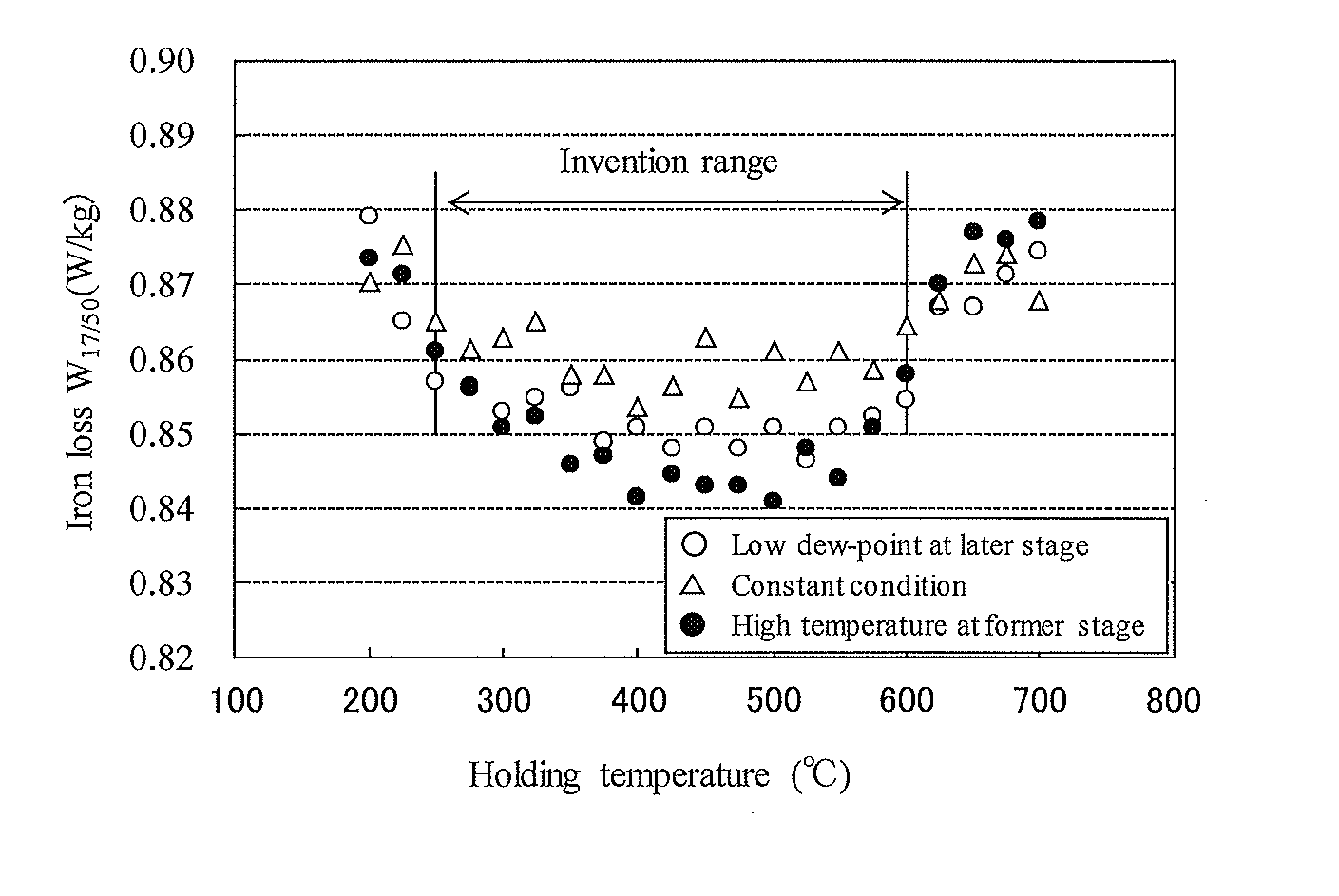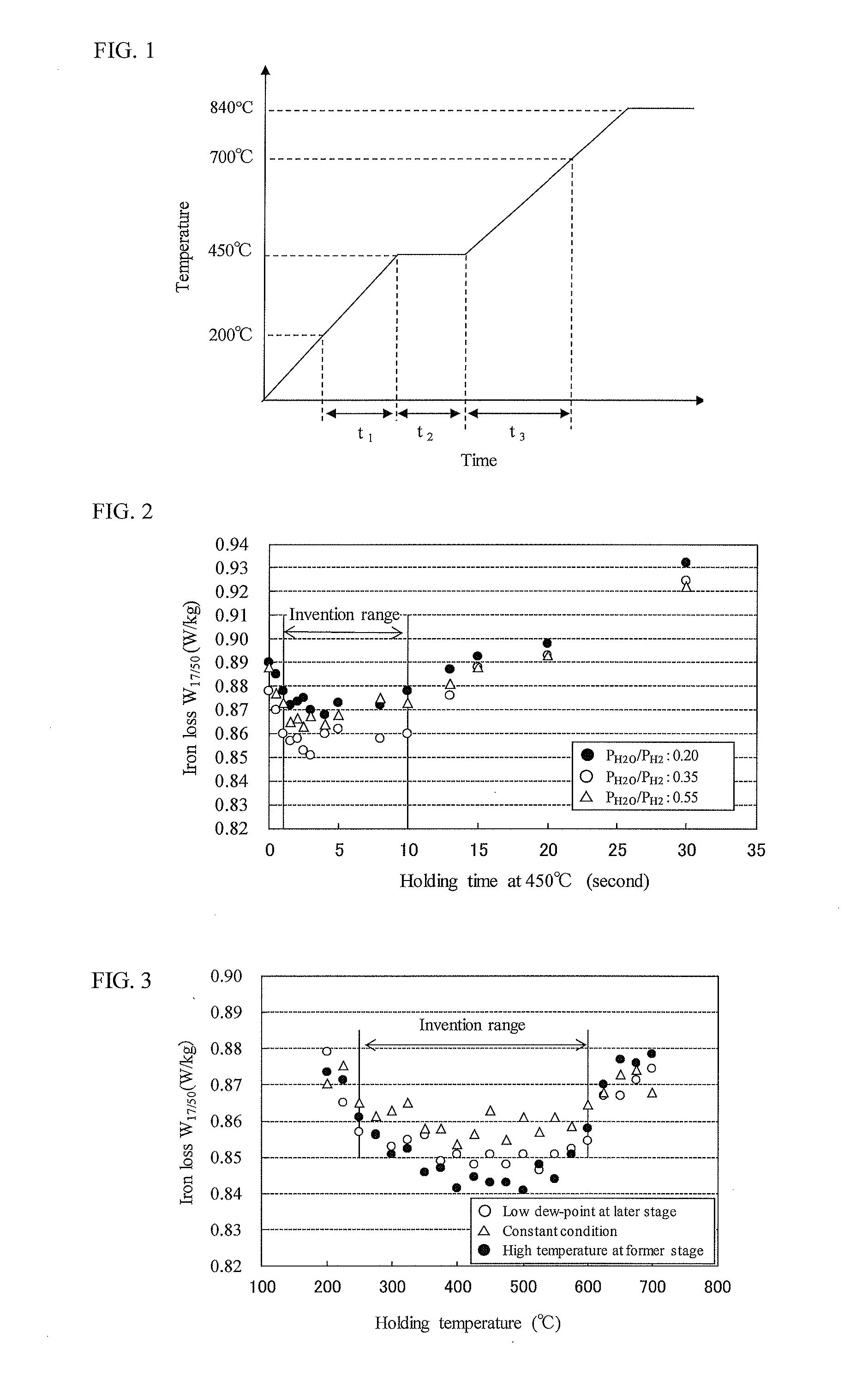Method for producing grain-oriented electrical steel sheet
a technology of electrical steel and grain-oriented, applied in the direction of heat treatment apparatus, magnetic bodies, furnaces, etc., can solve the problems of large defects in the internal oxide layer during heating, deviation of iron loss properties resulting from temperature variation, etc., and achieve the effect of stably providing grain-oriented
- Summary
- Abstract
- Description
- Claims
- Application Information
AI Technical Summary
Benefits of technology
Problems solved by technology
Method used
Image
Examples
experiment 1
[0026]A steel containing C: 0.065 mass %, Si: 3.44 mass % and Mn: 0.08 mass % is melted to produce a steel slab by a continuous casting method, which is reheated to a temperature of 1250° C. and hot rolled to obtain a hot rolled sheet of 2.4 mm in thickness. The hot rolled sheet is subjected to a hot band annealing at 1050° C. for 60 seconds and subsequently to a primary cold rolling to an intermediate thickness of 1.8 mm, and thereafter the sheet is subjected to an intermediate annealing at 1120° C. for 80 seconds and then warm-rolled at a sheet temperature of 200° C. to obtain a cold rolled sheet having a final sheet thickness of 0.27 mm.
[0027]Next, the cold rolled sheet is subjected to a primary recrystallization annealing combined with decarburization annealing by varying PH2O / PH2 in a wet atmosphere of 50 vol % H2-50 vol % N2 with holding the sheet at 840° C. for 80 seconds. The primary recrystallization annealing is performed by setting a heating rate from 200° C. to 700° C. i...
experiment 2
[0030]The cold rolled sheet obtained in Experiment 1 and having a final thickness of 0.27 mm is subjected to a primary recrystallization annealing combined with decarburization annealing wherein the sheet is held at any temperature within a temperature region of 200-700° C. in the heating process for 2 seconds. Moreover, the soaking process of the primary recrystallization annealing is performed under the following three conditions:
[0031]1) a uniform condition that the soaking is conducted at 850° C. for 150 seconds with PH2O / PH2 of 0.35.[0032]2) a low dew point condition at later stage that the soaking process is divided into a former stage and a later stage and the former stage is conducted at 850° C. for 120 seconds with PH2O / PH2 of 0.35 and the later stage is conducted at 860° C. for 30 seconds with PH2O / PH2 of 0.10.
[0033]3) a high temperature condition at former stage that the soaking process is divided into a former stage and a later stage and the former stage is conducted at ...
example 1
[0074]A steel slab comprising C: 0.070 mass %, Si: 3.35 mass %, Mn: 0.10 mass %, Al: 0.025 mass %, Se: 0.025 mass %, N: 0.012 mass % and the remainder being Fe and inevitable impurities is manufactured by a continuous casting method, reheated to a temperature of 1420° C., and then hot rolled to obtain a hot rolled sheet of 2.4 mm in thickness. The hot rolled sheet is subjected to a hot band annealing at 1000° C. for 50 seconds, a first cold rolling to provide an intermediate thickness of 1.8 mm, an intermediate annealing at 1100° C. for 20 seconds and then a second cold rolling to obtain a cold rolled sheet having a final thickness of 0.27 mm, which is subjected to a primary recrystallization annealing combined with decarburization annealing. In the primary recrystallization annealing, the following items 1)-3) are varied as shown in Tables 1-1 and 1-2:
[0075]1) Heating rate from 200° C. to 700° C. in the heating process;
[0076]2) Presence or absence of a holding treatment on the way ...
PUM
| Property | Measurement | Unit |
|---|---|---|
| Temperature | aaaaa | aaaaa |
| Temperature | aaaaa | aaaaa |
| Temperature | aaaaa | aaaaa |
Abstract
Description
Claims
Application Information
 Login to View More
Login to View More - R&D
- Intellectual Property
- Life Sciences
- Materials
- Tech Scout
- Unparalleled Data Quality
- Higher Quality Content
- 60% Fewer Hallucinations
Browse by: Latest US Patents, China's latest patents, Technical Efficacy Thesaurus, Application Domain, Technology Topic, Popular Technical Reports.
© 2025 PatSnap. All rights reserved.Legal|Privacy policy|Modern Slavery Act Transparency Statement|Sitemap|About US| Contact US: help@patsnap.com


